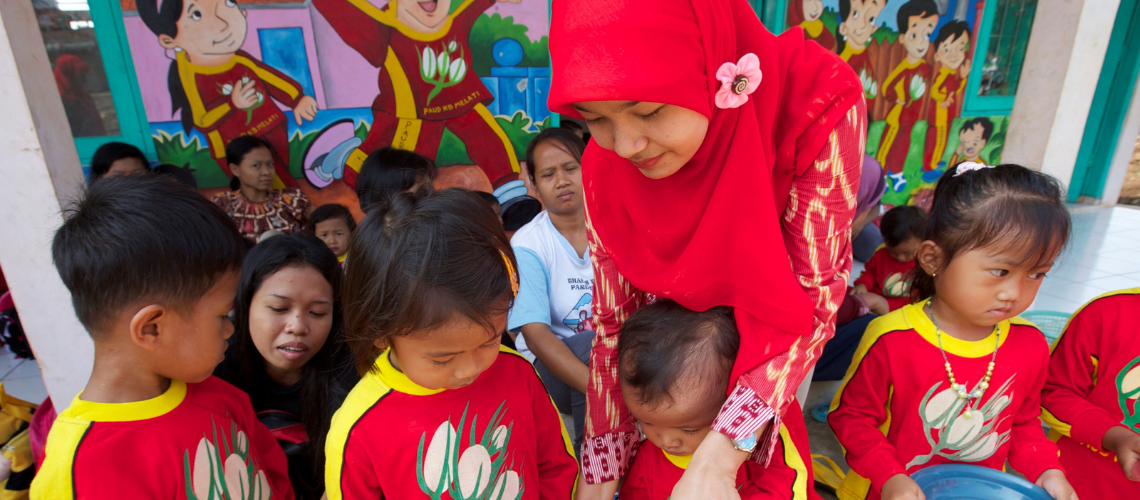 A teacher works with young students in a classroom
A teacher works with young students in a classroom
It’s well-documented that government investment in institutional childcare such as preschool or afterschool care has the potential to enhance children’s development and leads to increased female labor force participation (FLFP) – in other words, more working-age women joining the labor market (see recent review of the evidence here). However, it’s less known what types of jobs institutional childcare enables women to find: Are these jobs in the formal or informal sector? Paid or unpaid? If paid, are they sufficiently well remunerated to increase household welfare and women’s economic empowerment?
In the few low- and middle-income countries where this has been studied, the results are mixed. Recent studies in Chile and Kenya showed that institutional childcare services did not always lead to an increase in women’s income. In Mexico, childcare allowed women to work in the formal sector and more women to earn income. In Vietnam, where FLFP is high, while childcare did not nudge more women to work, it allowed women to switch from self-employment to wage and formal work and to earn higher annual wages.
Our paper, forthcoming in the journal Economic Development and Cultural Change, looks at the public preschool expansion in Indonesia. Our research reveals three important insights to add to the discussion of the role of institutional childcare in enabling mothers’ access to productive employment.
1. Public preschools increase female labor force participation in Indonesia
After the financial crisis of 1997, Indonesia passed legislation to revamp the national education system. This included two key initiatives: one that integrates early childhood education such as preschool in the national education system and another that requires national and regional governments to allocate 20 percent of their budget to education.
Public preschools in Indonesia serve children between the ages of 4 and 6 and are mainly intended to prepare students for primary education. They operate for only three to five hours a day, leaving a large gap in childcare. Mothers of preschool-aged children still need to find complementary alternative care arrangements if they want to access 8-hour-a-day type jobs.
Our paper seeks to answer whether this specific type of childcare — with its limitations — can nudge more women to work or to access different types of jobs, either paid or unpaid. We identified the causal impacts of public preschool expansion in Indonesia by exploiting three types of variation in a triple differences framework: 1) the different number of preschools in each district; 2) an increasing number of preschools within a district over time; and 3) the exogenous overlap with the timing when an individual mother has a preschool-aged child. We found that an additional preschool per 1,000 children in the district increases preschooler mother’s labor force participation by 9 percent.
2. Public preschools do not lead to improved job quality outcomes for women
However, across various dimensions of quality — income and types of employment — we found that public preschools do not shift women to a higher-quality employment. The increase in work participation was largely driven by an increase in the likelihood of being an unpaid family worker, which generally includes working in family farms or businesses without pay. While unpaid family workers contribute to household welfare, women do not directly earn income. Earning income can be beneficial for their intra-household bargaining power and overall economic empowerment. Due partly to the short operational hours of public preschools, women are unable to unlock better quality jobs with direct earnings such as salaried jobs or running a business.
3. Childcare needs to be designed to address women’s constraints in order to achieve transformative effects on their employment
Despite Indonesia’s robust economic growth over the past 40 years and success in halving the fertility rate from 4.6 in 1979 to 2.3 in 2018, FLFP in Indonesia has been stubbornly stagnant at around 50 percent since 1990. In 2019, it remained at 54 percent, lower than the 59 percent average in the East Asia and Pacific region. However, raising the FLFP rate in Indonesia to 59 percent by 2025 could increase annual economic growth rates by 0.7 percentage points above the current baseline.
As currently designed, public preschools offer a hopeful pathway to increase mothers’ participation in the labor market, but do not sufficiently address women’s constraints in accessing more productive or remunerative types of jobs. This represents a missed opportunity. The modality of preschools and/or the availability of complementary aftercare services could be adjusted with mothers’ constraints in mind to generate multiplicative effects for the economy. Future research could help identify the ideal set of measures to simultaneously benefit women’s access to better jobs and enhance children’s development.




Join the Conversation